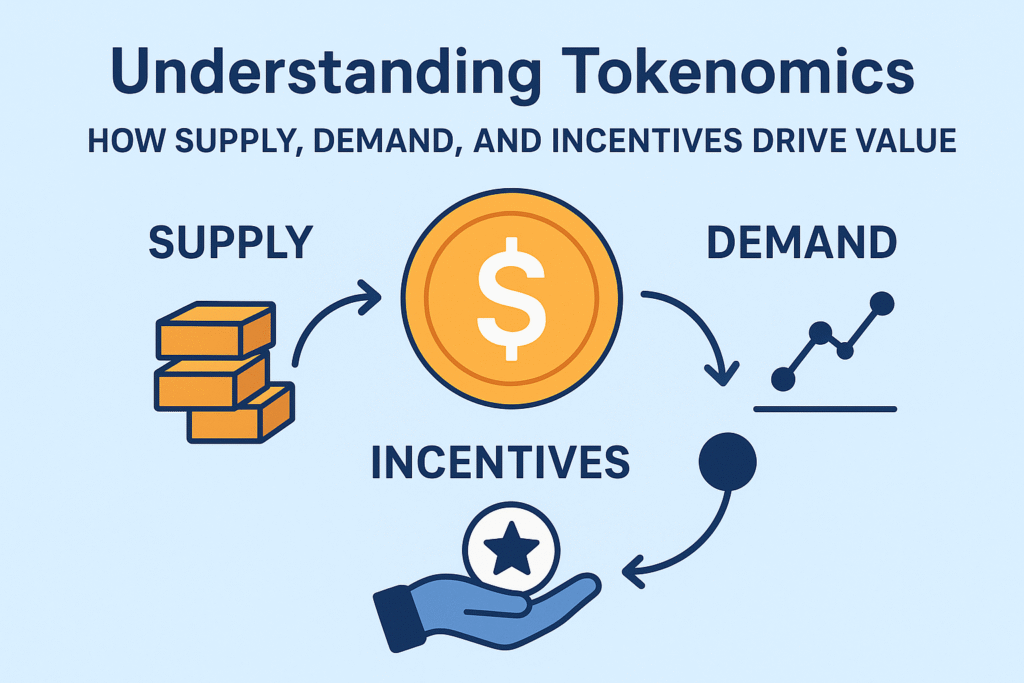Understanding tokenomics: how supply, demand, and incentives drive value
Tokenomics is the study of how a digital token’s economic system is designed and how that design influences its value. It sits at the intersection of economics, game theory, and software engineering. The core idea is simple: the way a token is created, distributed, used, and governed shapes who participates, what they do, and how much value the network can generate over time.
Supply dynamics: how many tokens exist and how they enter the market
– Fixed supply vs. inflationary supply: Some tokens have a hard cap, meaning only a finite number can ever exist. Others are minted over time, which can dilute holders if demand doesn’t keep up. The chosen model affects scarcity and price pressure.
– Emission schedule and vesting: New tokens may be released on a schedule (e.g., monthly) and often vest gradually to align long-term interests. Founders, team members, and early investors typically face vesting periods to reduce abrupt sell-offs.
– Burns and deflationary mechanics: Some protocols burn a portion of fees or rewards, reducing circulating supply over time. Burn events can create scarcity and provide price-supportive pressure.
– Circulating vs. total supply: The number of tokens actually available for trading (circulating supply) matters. A large portion locked in treasuries, staking, or vesting can mute short-term selling pressure but could delay expected network effects.
– Distribution and initial allocation: How tokens are distributed at launch (airdrops, private sales, public sale, ecosystem grants) affects decentralization, long-term engagement, and perceived fairness. Broad, merit- and activity-based distribution tends to support healthier network participation.
– Utility and scarcity trade-off: Scarcity alone doesn’t create value; it must be paired with useful functionality. A very scarce token with no use case may not attract sustainable demand.
Demand drivers: what makes people want to use or hold the token
– Core utility: Tokens that enable essential actions within a network—such as paying fees, staking to secure the system, or collateralizing a loan—gain real, ongoing demand. The more critical the token is to the network’s operation, the stronger the demand signal.
– Governance and voting rights: If holding the token allows participants to influence protocol upgrades, treasury allocations, or feature prioritization, demand can arise from owners seeking influence and alignment with the project’s long-term direction.

– Network effects and adoption: As more users, developers, and services join a network, its value can increase nonlinearly. Strong ecosystem activity creates positive feedback loops: more use leads to more liquidity, more developers build on top, attracting even more users.
– Liquidity and accessibility: Exchanges, stable trading pairs, on-ramps, and interoperable wallets reduce friction. High liquidity lowers transaction costs and makes the token a more attractive medium of exchange or store of value within the ecosystem.
– Staking, rewards, and incentives: Programs that reward holders or participants for contributing to security, liquidity, or governance can sustain demand. Clear paths to earning returns from participation help align incentives with network health.
– External demand drivers: Market sentiment, macroeconomic conditions, regulatory clarity, and competitive alternatives can influence demand. A token might also gain demand as collateral in other protocols or as part of cross-chain ecosystems.
Incentives and governance: aligning behavior to strengthen the network
– Alignment across participants: A well-designed token model incentivizes validators, developers, users, and liquidity providers to act in ways that grow the network rather than extract value in the short term.
– Validators and security: For proof-of-stake or other consensus mechanisms, staking rewards compensate participants who lock capital to secure the network. The incentive structure must balance security, decentralization, and economic efficiency.
– Developers and ecosystem growth: Grants, funding pools, and developer rewards encourage build-out of apps, integrations, and improved infrastructure—driving utility and organic demand.
– Users and network activity: Incentives can reward onboarding, participation in governance, or usage of the protocol. If users expect future value from a token through network growth, they may choose to hold or contribute rather than cash out immediately.
– Liquidity providers and market efficiency: Yield farming, liquidity mining, or rewards for providing token pairs expands liquidity. Adequate incentives here reduce slippage, improve price discovery, and support sustainable trading activity.
– Incentive design patterns: Common approaches include staking yields, time-based vesting to reduce short-term selling, buybacks with treasury burn, governance-based reward schemes, and tiered participation that rewards longer-term commitment.

Putting supply, demand, and incentives together: why tokenomics matter for value
– The value of a token is not just price; it’s the expected future utility and cash flows generated by the network. Supply constraints, demand drivers, and incentives shape those expectations.
– Token velocity matters: If a token changes hands quickly (high velocity) without corresponding growth in network value, price pressure can rise, creating a mismatch between utility and price. Slower velocity can help support sustained value when paired with strong network growth.
– Scarcity must be meaningful: A capped supply only translates to value if there is genuine demand for the token’s utility, governance power, or store-of-value properties. Without utility or demand, scarcity alone may not yield lasting value.
– Governance confidence and transparency: Clear, fair, and trustworthy governance reduces governance risk. When participants believe decisions reflect the long-term health of the network, confidence and participation tend to rise, supporting demand.
– Economic sustainability: A token model should balance issuance, burn, and incentives so that the token remains attractive over time. Models that rely too heavily on continual inflation or unsustainably high rewards risk diluting value or creating an unsustainable funding loop.
A practical framework to evaluate tokenomics
– Assess the supply model: Is there a cap? How is new supply issued or burned? Are there vesting schedules that prevent abrupt dilution? How broad is the distribution?
– Examine the demand proposition: What are the token’s use cases? How central is the token to the network’s operation? Are there compelling incentives to hold or use the token beyond short-term speculation?
– Scrutinize incentives: Do rewards align with long-term network health? Are there mechanisms to avoid centralization or abuse? How easily can participants maximize rewards without contributing to the network’s value?
– Review governance design: Who can participate? How transparent are proposals and voting? Is the decision process resilient to manipulation or capture by a small group?

– Consider risk factors: What about regulatory exposure, token concentration, or reliance on a single revenue stream? How resilient is the model to market downturns or technical failures?
– Look for measurable signals: emplaced metrics like total value secured, active users, number of builders, volume of on-chain activity, staking participation, and treasury health can indicate whether tokenomics are working as intended.
What this means for builders and investors
– For builders: Start with a clear use case and a sourcing model for tokens that aligns incentives with network growth. Design emission, burn, and vesting to support sustainable long-term participation rather than short-term hype. Foster broad, community-driven governance and transparent decision-making.
– For investors and users: Look beyond price to the economic design. Favor tokens with meaningful utility, robust incentive structures that promote healthy network growth, and transparent governance. Consider how changes to supply or incentives might affect long-term value and risk.
Illustrative examples (high-level patterns)
– Fixed-supply networks with strong utility: Networks where a capped supply underpins a widely used service—e.g., a token that unlocks essential decentralized financial activities—tend to develop durable demand if the service scales.
– Inflationary-but-deflationary blend: A token with ongoing minting that also burns a portion of fees can achieve growth through increased utility while maintaining a reducing net supply over time if burn outpaces new issuance.
– Governance-forward tokens: Tokens designed to give holders real say in protocol direction can attract users who value control and alignment with long-term outcomes, assuming governance is accessible and meaningful.
Conclusion
Understanding tokenomics means looking at three intertwined elements: how many tokens exist and how they enter or exit circulation, what drives demand for the token, and how incentives are structured to align participant behavior with the network’s long-term health. The most durable value emerges when a token’s supply schedule, use cases, and incentive design reinforce each other to encourage active participation, sustainable growth, and credible governance. As with any emerging technology, careful analysis, sound design, and ongoing community engagement are essential to creating a resilient and valuable token ecosystem.

